
|
||
|
Portland art blog + news + exhibition reviews + galleries + contemporary northwest art
|
||
Eugene on the move 
Morphosis' unfinished courthouse in Eugene (*update: Port's review and pictures of the finished courthouse) It had been several years since I made the hour and a half trek south to Eugene but this was my chance. With a new museum, a 35 year retrospective and one of the most exciting new buildings in America (by Morphosis) under construction there was plenty to see. 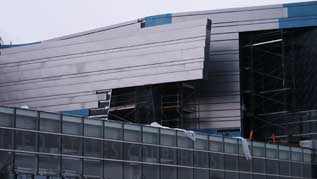
It isn't done yet but the new Wayne L. Morse United States Courthouse by Thom Mayne is the first building to threaten Rem Koolhaas' Seattle Central Library as the coolest new building in the Pacific Northwest (although I doubt a courthouse can beat the planet's best new public building in the last 25 years). Artists featured are international star Matthew Ritchie, the Bay Area's Kris Timken and Portland's own rising national star Sean Healy. The building opens this summer. For more info check out the official website. 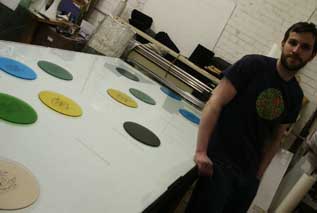
Sean Healy in one of his Portland facilities Healy is creating a number of glass doors (with images of people from Eugene) which jurors will pass through like a civic Scilla and Charybdis. It's an interesting idea that from what I've seen should be one of the more engaging public art projects around. It's absolutely accessible but in Sean's typical wry and challenging way, it obliquely questions how one conceives of their peers.... all through the use of transparent and semitransparent glass. 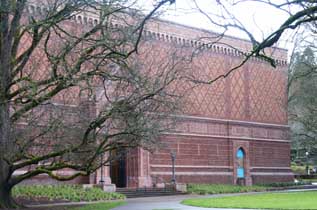
The New Jordan Schnitzer Museum of Art at the U of O Eugene is also the home of the new Jordan Schnitzer Museum of Art. I like the Art Nouveau/Moorish facade in these days of cultural polarization. The building's insides are very different from the one I remembered before the renovation, completed last year. Luckilly they kept the courtyard, which I've always considered a jewel. All museums should have inner sanctums and this one's is open to the sky. The galleries have some surprises including an ok Franz Klein, a very good Adolf Gottlieb, a swell Frank Stella and a surprising Barnett Newman on paper. The Jenny Holtzer pops up when you least expect it as well and I can't help but think that any of these works would be major gap fillers in the Portland Art Museum's collection. It is totally surprising to find it here and it will make your trip to Eugene from Portland absolutely worth it. As far as the current art faculty show, Eye Contact (open through April 9th), it looks a lot like an uncluttered version of the 2003 Oregon Biennial. The room itself is gorgeous, the best gallery space in the state. Overall, the show is a bit stiff and academic, but it definitely proves they still have the best art program in the state (PNCA and PSU's faculty are producing a lot edgier work though). Painters like Carla Bengston and Jan Reeves both have fresher pieces here compared to their work in the 2003 Oregon Biennial. Whereas Amanda Wojick, one of my favorite artists in the state (who was also in the 2003 Oregon Biennial) didn't have some of her strongest work on view here. It seemed unfocused and jumbled... the form lacked definition and seemed a bit unfinished. Hopefully her work in the upcoming 2006 Biennial will avoid this problem with sophomore sequel jinxs. Laura Vandenberg's drawings stood out as well but more as an installation of a swarm of drawings. Individually few really stood out, she's in the upcoming Oregon Biennial as well. 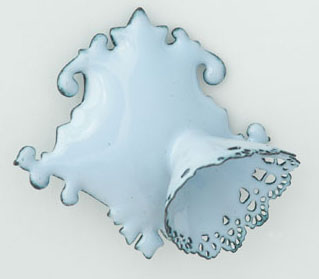 Kivarkis' Brooch (2005) The best things in the show were Anya Kivarkis' strange jewelry designs. Their odd surfaces and intriguing designs make me wonder if the jewelers here are better because they are held to more competitive standards? There are soo many jewelry makers littering the planet but these pieces really confuse me in a way that most painters and installation artists don't anymore. Jewelers generally work to higher tolerances and maybe I'm attracted to them because of the current slap dash fetish of a lot of contemporary art now. 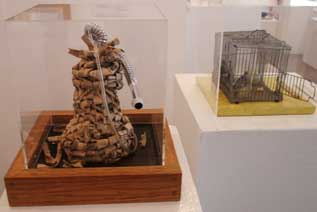 (L) The Medium is the Message and (R) Chain of Events Cage by Mike Walsh Last but not least, the Mike E. Walsh show Timeline (which ended on March 30th) at the Maude Kerns Art Center was very provocative. Situated in a reconnoitered church, this show of 35 years of output seemed to pack every inch of the space. The artist, an Oregon native and Columbia University grad presented 2 distinct but related bodies of work; dioramas or vitrines and installations. Both genres tackle sociopolitical subject matter like; ritualism, HIV Aids, burials, the Vietnam War, Australian Aboriginal culture and pop culture with characteristic 70's pluralism. Here is a tour of some highlights: Many of the vitrines and dioramas are very accomplished assemblages and works like Standard Scales, 1981 or Palt (Together Alone), 2001 display a real sensitivity for ritualized material usage that belies their syncretic cultural combinations. 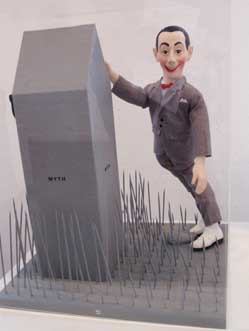 Peewee Myth (1990) Other favorites were Peewee Myth, Omen and It's the Law all of which all feel like HC Westerman meets Jennifer Bartlet by way of Roy Lichtenstein. But it's his grittier earlier works like attachment #35, 1975 or The Medium is the Message, 1972 which really shine with their Joseph Cornell meets Robert Rauschenberg poetics. This took a more ritualized memorial turn in 1976 with Ritual Burial Project which was included in the 1978 Oregon Biennial. In 1980 he completed Chain of Events Cage, it works perfectly with The Medium is the Message but it seems more personal. Walsh, a decorated Vietnam Veteran and world traveler has had plenty of opportunities for personal reflection in the last 35 years and the depth shows. His installation work addresses Vietnam and HIV AIDS expanding upon and complicating the vocabulary of the more portable pieces. His Lest We Forget: a dialog on AIDS, is pure social conceptual art but it is spatially conceptual by bringing elements of the outdoors, like leaves, indoors. It's also symbolic of the lives lost and the continuing tragedy of AIDS.  Lest We Forget: A Dialogue on AIDS (1999) The show ended March 30th but an institution in Portland should consider him for his 40 year retrospective. *update: Port's review and pictures of the finished courthouse by Thom Mayne Posted by Jeff Jahn on April 03, 2006 at 23:25 | Comments (2) Comments Mike E. Walsh's socially engaged conceptualism has been doing and saying what it wants for 35 years. He keeps his course, changing the forms, adjusting the themes, renewing the commitment. In his new 2006 installation "Palace Walk: Codex B, Egyptian Series," picturing 92 American soldiers killed in Iraq, he carries the case for art as political agument into the post 911 present. Walsh is one of the most engaging artists currently working in the Northwest and for that matter the US. Posted by: Ted Smith110 Visual artists of the 21st century, like Mike E. Walsh, refuse to repress the realities of AIDS - his seven AIDS installations, in his recent retrospective, date from 1985-2006, and insist on testifying to the truth of AIDS. The great loss to the arts community regionally (Portland gallery director/artist: William Jamison; Portland painter: August Encalada; Portland actors: Jerry Leith, Terry Nelson, Dennis Spaight, Rex Rabold, Jerry West; Portland opera singer: Ariel Rubstein; and Seattle painter: Michael Ehle) and nationally (Felix Gonzalez-Torres, Keith Haring, Robert Mapplethorpe, Frank Moore and David Wojnarowicz) - and the list goes on and on! Walsh's memorials to artists, "Lest We Forget: A Dialogue on AIDS," teaches us much that we need to know about dying while giving permission to mourn. And after all, to be mortal is by definition to have to learn to mourn. In the next century art historians will look back at Walsh as a pioneering social conceptualist who dared to make a difference. Posted by: markadams Post a comment Thanks for signing in, . Now you can comment. (sign out)
(If you haven't left a comment here before, you may need to be approved by
the site owner before your comment will appear. Until then, it won't appear
on the entry. Thanks for waiting.)
|
| s p o n s o r s |
 |
 |
 |
 |
 |
 |
 |
 |
 |
 |
 |
 |
 |
 |

|
Site Design: Jennifer Armbrust | • | Site Development: Philippe Blanc & Katherine Bovee | |


![[TypeKey Profile Page]](http://www.portlandart.net/nav-commenters.gif)